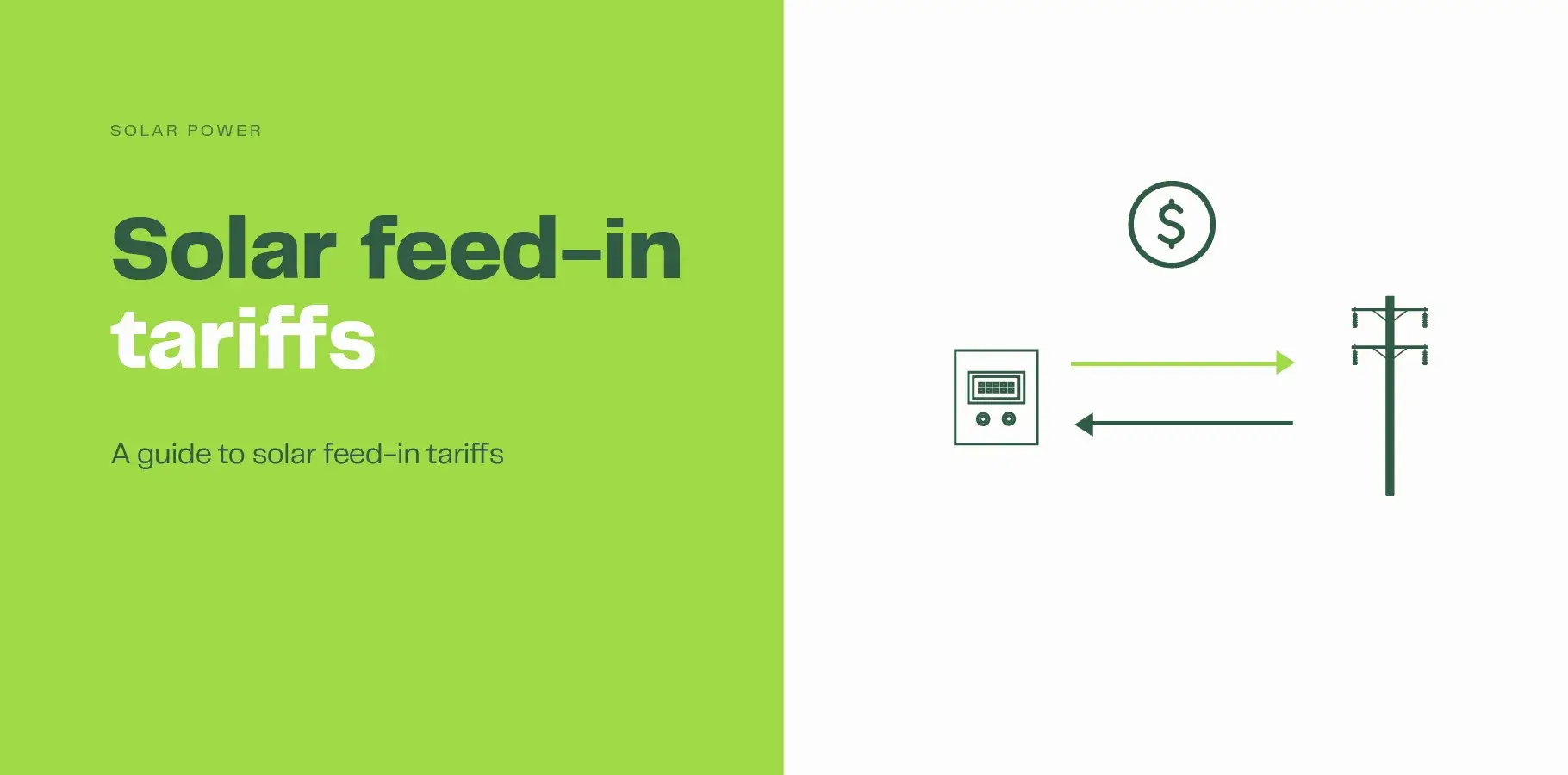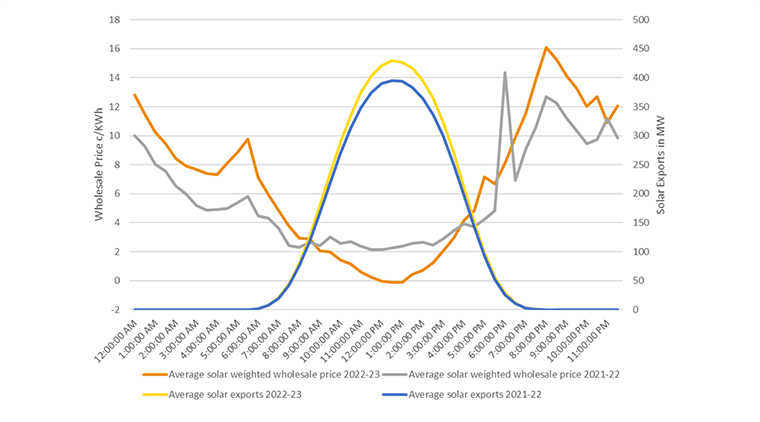Solar feed-in tariffs: What you need to know
A complete guide to understanding and finding the best feed-in tariff.
Last updated: January 2024
Reading time: 4 minutes
Across Australia, there are different financial incentives to help homeowners switch to solar. From rebates to loans, these programs are designed to reduce the cost of installing rooftop solar.
One incentive available across the country is the solar feed-in tariff, which can help offset the cost of solar on an ongoing basis and help to reduce system payback times.

In this article, we’ll cover everything you need to know about solar feed-in tariffs and help you find the best rate for your location.
What is a solar feed-in tariff?
A solar feed-in tariff, also known as the solar bonus scheme or solar buy-back scheme, is a credit you receive for the excess solar energy generated by your system that is exported to the grid.
Feed-in tariffs can be regulated by government, or offered by electricity retailers.
How do feed-in tariffs work? Why export energy?

Sometimes, your solar panels produce more energy than you need to power the appliances in your home directly. This energy must go somewhere, so unless your solar system includes battery storage, it’s sent back to the grid for others to use.
Nearly all system are configured to work this way, it is called net metering.
Feed-in tariffs are paid as a credit on your electricity bill, providing a long-term, ongoing kickback to help you pay back your solar system.
State-by-state solar feed-in rates
Feed-in tariff rates differ from state to state. Some state governments set the rates, while in other states, it’s up to the energy retailers to set a competitive market price.
The table below shows feed-in tariffs for each Australian state and territory:
| State | Retailer | Min FiT | Max FiT |
|---|---|---|---|
| Victoria | AGL | 4.9c | 15.0c |
| Victoria | Energy Australia | 5.4c | 5.4c |
| Victoria | 1st Energy | 4.9c | 9.9c |
| Victoria | Origin Energy | 4.9c | 20.0c |
| Victoria | Simply Energy | 4.9c | 4.9c |
| Victoria | Not listed | 5.0c | 5.0c |
The best feed-in tariffs Victoria
Victorians have the option to choose between a fixed flat rate of at least 4.9 cents per kilowatt hour, or one of two time-varying options ranging from 3.9 cents to 11.3 cents, depending on the time of day.
Discover all the solar rebates and incentives available in Victoria.
| State | Retailer | Min FiT | Max FiT |
|---|---|---|---|
| NSW | AGL | 7.0c | 15.0c |
| NSW | Energy Australia | 7.6c | 7.6c |
| NSW | Red Energy | 6.0c | 12.0c |
| NSW | Origin Energy | 7.0c | 20.0c |
| NSW | Powershop | 5.0c | 5.0c |
| NSW | Simply Energy | 5.5c | 5.5c |
The best feed-in tariffs NSW
There is no minimum feed-in tariff in New South Wales; rates vary depending on your electricity provider and typically range between 5c – 15.0c.
Discover all the solar rebates and incentives available in New South Wales.
| State | Retailer | Min FiT | Max FiT |
|---|---|---|---|
| QLD | AGL | 5.0c | 15.0c |
| QLD | Red Energy | 5.0c | 16.0c |
| QLD | Energy Australia | 6.6c | 6.6c |
| QLD | Simply Energy | 5.5c | 5.5c |
| QLD | Origin Energy | 5.0c | 20.0c |
The best feed-in tariffs QLD
If you live in South East Queensland, your feed-in tariff rate is set by your electricity retailer. If you live in regional Queensland, you will receive a flat rate of 13.441c per kilowatt-hour.
Discover all the solar rebates and incentives available in Queensland.
| State | Retailer | Min FiT | Max FiT |
|---|---|---|---|
| SA | AGL | 6.0c | 6.0c |
| SA | Energy Australia | 8.5c | 8.5c |
| SA | Momentum Energy | 3.5c | 3.5c |
| SA | Origin Energy | 6.0c | 20.0c |
| SA | Simply Energy | 5.5c | 5.5c |
The best feed-in tariffs SA
South Australian feed-in tariffs vary according to your retailer but typically range between 3.5c – 8.5c. Electricity prices in SA are higher, so there is more incentive to invest in solar power.
Discover all the solar rebates and incentives available in South Australia.
| State | Retailer | Min FiT | Max FiT |
|---|---|---|---|
| WA | Horizon Power | 3.0c (Off peak) | 10.0c (Peak) |
| WA | Synergy | 2.25c (Off peak) | 10.0c (Peak) |
The best feed-in tariffs WA
In Western Australia, feed-in tariffs are available under the Distributed Energy Buyback Scheme (DEBS).
The rate in Perth is set lower than in other states, at 2.25c per kWh during off-peak times and 10.0c during peak periods. The lower rate is offset by the abundance of sunshine hours, making solar power in Western Australia a great investment.
If you live in a regional area, you will receive a better feed-in tariff; the exact rate varies depending on your location.
Discover all the solar rebates and incentives available in Western Australia.
| State | Retailer | Min FiT | Max FiT |
|---|---|---|---|
| TAS | Aurora Energy | 10.9c | 10.9c |
| TAS | Not listed | 10.9c | 10.9c |
Tasmania solar feed-in tariff
The Tasmanian Economic Regulator sets feed-in rates in the Apple Isle. The minimum rate is locked in at 10.869c/kWh until Jun 2024, up 22.4% from the previous year.
Since there’s only one rate available, there’s no point in comparing rates to find the best feed-in payment.
| State | Retailer | Min FiT | Max FiT |
|---|---|---|---|
| ACT | Actew AGL | 10.0c | 15.0c |
| ACT | Energy Australia | 7.6c | 12.0c |
| ACT | Origin Energy | 8.0c | 12.0c |
| ACT | Energy Locals | 7.1c | 7.1c |
| ACT | Red Energy | 6.0c | 6.0c |
Feed-in tariff ACT
Feed-in tariffs across the ACT vary according to your retailer, typically between 6c – 15c per kWh.
| State | Retailer | Min FiT | Max FiT |
|---|---|---|---|
| NT | Rimfire Energy | 11.0c | 11.0c |
| NT | Jacana Energy | 8.3c | 8.3c |
Feed-in tariff Northern Territory
The Northern Territory boasts some of the most competitive feed-in tariffs in the country, with rates ranging between 8.3c – 11.0c per kWh.
How do current rates compare to historical rates?
The value of feed-in tariffs has decreased over the years.
Typically, feed-in tariff rates reflect wholesale electricity prices and the demand for energy at a particular time of day. Most solar energy is exported to the grid during the middle hours of the day when wholesale prices and energy demand are low. Only 0.5% of solar energy is exported after 5pm when energy demand is high1.
This large difference between solar exports and wholesale prices – illustrated on the graph below – explains why feed-in tariff rates are lower than they used to be.

Solar Duck Curve Graph showing average solar exports vs wholesale electricity prices 2
This trend is likely to continue: as more homes switch to solar, more energy will be exported to the grid when household consumption is typically low, driving a further gap between solar energy exports and wholesale prices.
How to manage feed-in tariffs: Self consumption vs exporting energy
With this gradual reduction in feed-in tariff rates, we wouldn’t advise homeowners to install an excessive solar system with the plan to profit from their excess energy.
It is much better to self-consume your solar power rather than export it back to the grid in return for a feed-in tariff. You pay a much higher rate when you buy electricity from the grid than you receive for exporting your clean energy. Therefore, feed-in tariffs play a major role in the economics of determining the suitability of solar power for your home.
How much will self consumption save me?
The rate to buy electricity from the grid is typically much higher than the rates for feeding electricity into the grid, so managing your usage can be a better strategy than chasing feed-in tariffs.
Typically, your solar power system will generate more power during the day than you use in your home. Imagine you receive an average feed-in tariff of 10c whilst paying your retailer 30c for every kWh you buy from the grid.
The difference between the two rates is 20c; this is how much you will save if you self-consume your solar power during daylight hours.
You can increase your daytime usage by scheduling appliances like dishwashers to run during the day, charging your devices during the day, and identifying any other energy habits you can optimise.
Next steps
Learn more about the rebates and incentives available in your state to help you make the switch:
References
- IPART paper on value of solar exports, Independent Pricing and Regulatory Tribunal.
- Essential Services Commission.

Are you ready for the benefits of solar?
Get 3 free quotes and start your journey towards making the switch.
Get free quotes
